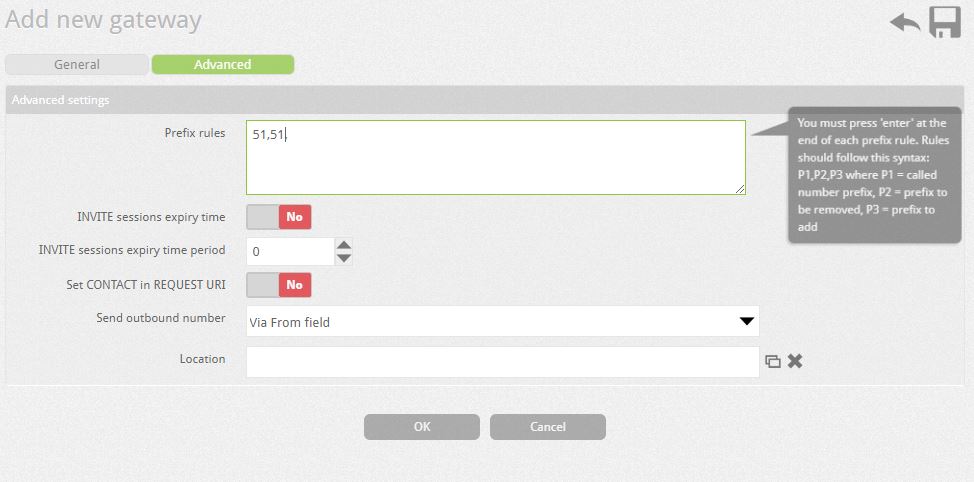The gateways represent the entities through which the PBX communicates with the outside world, in other words, they represent the interface with the telephone lines of the company. A gateway can be a hardware device physically connected to the company’s telephone lines (ISDN, Analog, GSM), or it can be a VoIP operator. In the Cloud architecture of VOIspeed, the hardware gateways (ISDN, GSM, Analog) authenticate themselves on the server as if they were a user, therefore the switchboard administration will have to create the authentication credentials
On the gateways that represent VoIP operators, instead, it is the PBX that authenticates itself on the operator as usual.
| Parameter | Description |
| Company | It’s the current company you’re working on (not editable) |
| Type | Indicates the type of physical interface to which the gateway connects. Precisely: VOIP: VoIP ISDN operators: indicates an ISDN gateway on basic access or primary access (eg Mediatrix 440X) GSM: indicates a GSM gateway (eg V-6021, 2N) Analog Line: indicates a gateway for analogue FXO lines ( eg Mediatrix C730, Patton 4112) |
| Qualified | Activate or deactivate the gateway |
| First name | Gateway name ( required ) |
| Lines | The number of total lines that the gateway can manage. Indicate the exact number of channels or lines available on the gateway. Examples: ISDN: 2 lines for each basic BRI access (ISDN socket, or ISDN port of a router if supplied by another operator) ISDN: 30 lines for entire primary access, 15 for primary fractioned GSM accesses: 1 line for each SIM inserted in the gateway Analog Line: 1 VoIP line : varies according to the case. Enter the number of available lines calculated based on the available bandwidth in upload (each conversation with the G.729 compressed codec takes up about 20kbps, each G.711a uncompressed conversation takes up about 80kbps). If the operator places a restriction on the number of lines, set the same number, as long as it is compatible with your ADSL connection. |
| Exit number | It allows you to specify the exit number (CLID or caller ID) when the gateway uses the telephone line. This allows you to appear outside with the desired number, as long as the interrogated gateway supports this function. The available options are:
|
| Domain | Indicates the domain of the VoIP operator (eg voip.eutelia.it) |
| User ID |
In the UCloud architecture, hardware gateways (ISDN, GSM, Analog) all require authentication as if they were a user. For this reason, it is necessary to create the account here (username and password). Attention, do not use characters in this field. Set the telephone number of the telephone line as the User ID. If you have more than one gateway with the same number, use a different number (for example the main number with an extra digit). This new number must obviously be entered as a company number |
| RTP flow tracker | Valid only for VoIP Operators: by default, it is always deactivated and should only be activated if the VoIP operator supports peer to peer communications between terminals, where the PBX does not bypass RTP flows |
| Requires registration |
Indicates whether the gateway requires authentication or not. It is normally used for VoIP operators. Furthermore, in the UCloud architecture, all gateways (eg GSM, FXO, ISDN) require registration. Activating this option you will be asked: realm, username, password and authentication period (register timeout).
Tip: set the phone number of the telephone line as username. |
| Realm | Very important for VoIP operators: it must coincide with the Realm communicated by the operator. In the event of failure to register, check the Realm column in the gateway monitoring: that represents the true expected value, taken from the PBX by the operator’s SIP reply packets. Sometimes the commercial offices of the operators account data are incorrect (among these the Realm is the most susceptible to errors). |
ADVANCED CONFIGURATIONS
In this section, you can manage adding/removing prefixes to/from numbers after being commissioned by the gateway. The Prefix Rules field allows you to insert rules for adding or removing the desired prefixes. It is possible to insert more than one rule (one per line) and each of them must have the following syntax:
P1, P2, P3 where P1 = prefix number called, P2 = prefix to remove, P3 = prefix to add. The comma is considered as a separator, so if there is no prefix to add or remove, you don’t need to write anything but leave the comma as a separator.
 This function is very useful when you want to engage the gateway by prefixing the dialled number: after the call is managed by the gateway the prefix must be removed otherwise the call would be forwarded to the gateway for a non-existent number.
This function is very useful when you want to engage the gateway by prefixing the dialled number: after the call is managed by the gateway the prefix must be removed otherwise the call would be forwarded to the gateway for a non-existent number.
Example: to exit with the desired operator, the user must prefix to the number to be called (eg: 510612345678). In the Advanced section of the Gateway, enter rule 51.51, (leaving the last field with the last comma as the last field). This means that calls for numbers starting with 51 will be turned into calls for numbers without the same prefix.
It is also possible to make the gateway add a prefix to the numbers entered by the users because, for example, it is connected to a SIP device (eg GSM / UMTS multi-SIM gateway ) that routes calls on its resources based on a prefix.
Example: the user must exit the SIM 1 of a GSM gateway transparently when calling mobile phones; the GSM gateway uses the prefix 5 to engage the SIM1 (which then removes internally). In the advanced section of the gateway, it will be necessary to insert the following string: 3 ,, 5 which indicates that to the mobile numbers (prefix 3 …), VOIspeed will add the prefix 5 and send it to the GSM gateway as 53 … The GSM gateway will, therefore, have to take care of the removal of the prefix once it has engaged the desired SIM.
NOTE: in order for the convenience numbers to be sent to the gateway, a routing rule must also be created for that prefix, otherwise the PBX would not be able to route the call to the gateway. In fact, these rules only apply AFTER the call has been routed to the gateway itself.


 , &
, & 
 serve respectively to eliminate, refer to the properties of the gateways and change configurations.To create a new gateway, enter the Configuration – Gateways page and click on the button.
serve respectively to eliminate, refer to the properties of the gateways and change configurations.To create a new gateway, enter the Configuration – Gateways page and click on the button. The window for creating the gateway will appear, which depending on the type will show some fields (see below).
The window for creating the gateway will appear, which depending on the type will show some fields (see below).



